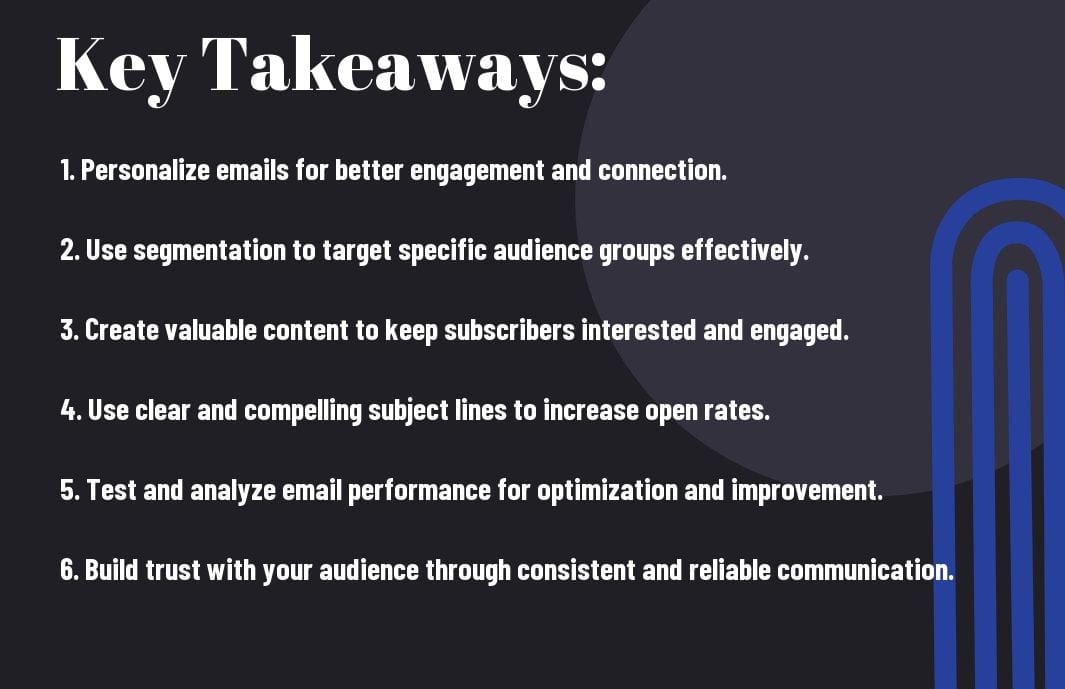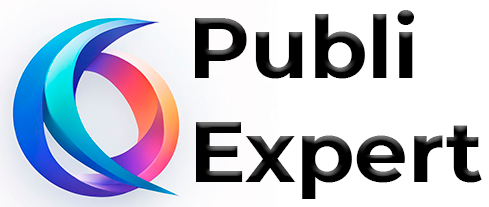Many businesses underestimate the power of email marketing in building a stronger connection with their audience. By capturing your audience’s attention in their inboxes, you have a direct line to communicate and engage with them on a more personal level. This can lead to increased brand loyalty, higher conversion rates, and ultimately, business growth.
Key Takeaways:
- Segment Your Audience: Identifying different groups within your email list allows you to create targeted and personalized content that resonates with each segment.
- Use Automation Wisely: Automation tools can help you streamline your email marketing efforts, but it’s important to use them strategically to maintain a personal touch and avoid overwhelming your audience with irrelevant content.
- Focus on Engagement: Encourage interaction with your audience by including interactive elements like polls, surveys, or user-generated content in your emails. Building a two-way communication channel strengthens the connection between you and your subscribers.

Understanding Your Audience
Creating Audience Personas
On the journey to mastering email marketing, one of the key elements is understanding your audience. Assuming that you already have a general idea of who your target audience is, creating audience personas can provide deeper insights into the preferences, behaviors, and needs of your subscribers. These personas are fictional representations of your ideal customers, based on data and research.
Segmenting Your Email List for Better Targeting
Audience segmentation is a crucial step in email marketing that involves categorizing your subscribers into different groups based on their characteristics, interactions, or preferences. Audience segmentation allows you to tailor your email content and messages to specific segments, increasing relevance and engagement. By sending more targeted and personalized emails, you can improve open rates, click-through rates, and ultimately, conversions.
Targeting specific segments within your email list can lead to higher success rates in your email marketing campaigns. Understanding the distinct needs and interests of different segments enables you to craft compelling messages that resonate with each group. This level of targeting can result in increased engagement, customer loyalty, and ultimately, improved ROI for your email marketing efforts.
Crafting Effective Email Content
The Art of the Subject Line
Not only is the subject line the first thing your audience sees, but it is also the deciding factor in whether your email gets opened or sent straight to the trash. An attention-grabbing subject line is crucial for a successful email marketing campaign. It should be concise, relevant, and intriguing, piquing the curiosity of your subscribers and enticing them to click open.
Body Content That Engages
Any successful email marketing campaign hinges on the quality of the content within the body of the email. This is where you have the opportunity to truly connect with your audience, convey your message, and provide value. To keep your readers engaged, make sure your content is personalized, relevant, and speaks directly to their needs and interests. Utilize a mix of compelling visuals, informative text, and a clear call to action to keep your subscribers hooked.
Line breaks and bullet points can help break up large chunks of text and make your content more visually appealing. Additionally, segmenting your email list based on subscriber preferences and behaviors can help ensure that the content you’re sending is targeted and resonates with each individual reader.
Calls to Action That Convert
EngagesYour call to action (CTA) is the key to driving conversions and getting your subscribers to take the desired action. Whether it’s making a purchase, signing up for an event, or simply clicking through to your website, a strong CTA can significantly impact your email’s success. Make sure your CTA stands out by using compelling language, a prominent placement within your email, and a clear sense of urgency. Consider using buttons or hyperlinked text to make it easy for subscribers to take action.
Plus, don’t forget to test different CTAs to see which ones resonate best with your audience and drive the highest conversions. By continually optimizing your calls to action, you can ensure that your email content is always driving the results you want.
Designing Emails for a Better User Experience
The Role of Visuals in Email Marketing
All successful email marketing campaigns have one thing in common – compelling visuals. Visuals play a crucial role in grabbing the reader’s attention and conveying your message effectively. Whether it’s a striking image, an eye-catching infographic, or a well-designed layout, visuals can make your emails more engaging and memorable. When designing your emails, make sure to incorporate visuals that are not only aesthetically pleasing but also relevant to your content. By striking the right balance between text and images, you can create an email that is visually appealing and increases the chances of user engagement.
Mobile Responsiveness and Accessibility
To ensure that your emails reach the widest possible audience, mobile responsiveness and accessibility are non-negotiable. In today’s digital age, the majority of people check their emails on their smartphones or tablets, so it’s important that your emails are optimized for mobile devices. Failure to do so can result in a poor user experience, leading to decreased open rates and engagement. When designing your emails, test them on different mobile devices to ensure they are easy to read and navigate. Additionally, make sure that your emails are accessible to users with disabilities by including alt text for images and using clear, easy-to-read fonts.
Mobile responsiveness and accessibility are not just nice-to-haves; they are important components of a successful email marketing strategy. By prioritizing these factors, you can ensure that your emails are reaching your audience effectively and providing a positive user experience across all devices.
Timing and Frequency of Emails
Your Mastering Email Marketing: Effective Strategies For Success efforts can greatly benefit from a strategic approach to timing and frequency of emails. By understanding the best practices for email scheduling and managing email frequency, you can enhance engagement with your audience and drive better results for your email campaigns.
Best Practices for Email Scheduling
To optimize your email marketing efforts, it’s crucial to consider the timing of your email sends. Research shows that the best days to send emails are typically Tuesday, Wednesday, and Thursday. Additionally, it’s recommended to send emails in the late morning or early afternoon when people are more likely to check their inboxes. By scheduling your emails during these peak times, you can increase the chances of your emails being seen and opened by your audience.
Managing Email Frequency and Avoiding Fatigue
Timing plays a crucial role in email marketing success, but so does managing the frequency of your emails. While it’s important to stay top of mind with your audience, bombarding them with too many emails can lead to email fatigue and ultimately result in higher unsubscribe rates. It’s crucial to find the right balance in your email frequency to avoid overwhelming your subscribers.
Automation and Personalization Techniques
Implementing Automation for Efficiency
Automation is a game-changer when it comes to streamlining your email marketing efforts. By setting up automated workflows, you can ensure that your audience receives relevant content at the right time without you having to manually send each email. This not only saves you time but also ensures consistency in your communication.
With automation, you can set up triggers based on user behavior, such as website visits or email opens, to send targeted emails that resonate with your audience. This level of efficiency allows you to focus on creating quality content while the automation takes care of the delivery.
The Power of Personalization
One of the most effective techniques to strengthen your connection with your audience is personalization. By tailoring your emails to the specific interests and preferences of each subscriber, you can significantly increase engagement and conversion rates. Personalized emails are more likely to capture the attention of your audience and make them feel valued.
With personalization, you can address your subscribers by their names, recommend products based on their previous purchases, and send content that is tailored to their browsing history. This level of personalization shows your audience that you understand their needs and makes them more likely to engage with your emails.
Measuring Success and Optimizing Campaigns
Many businesses invest time and resources in email marketing campaigns to reach their target audience and drive specific outcomes. However, without measuring success and optimizing campaigns based on data-driven insights, it’s challenging to achieve the desired results. To build a stronger connection with your audience, it’s crucial to track key metrics that provide valuable information about the performance of your email campaigns.
Key Metrics to Track
Any successful email marketing strategy hinges on tracking key metrics that offer insights into the effectiveness of your campaigns. Some of the necessary metrics to monitor include open rates, click-through rates, conversion rates, bounce rates, and unsubscribe rates. By analyzing these metrics regularly, you can identify patterns, trends, and areas for improvement in your campaigns.
A/B Testing and Continuous Improvement
On the journey to mastering email marketing, A/B testing plays a vital role in optimizing your campaigns for better results. By comparing two versions of an email with slight variations in elements like subject lines, content, or call-to-action buttons, you can determine which version resonates better with your audience. This iterative process of testing, analyzing results, and implementing changes can lead to significant improvements in your email marketing performance over time.
For instance, by conducting A/B tests, you may discover that a personalized subject line leads to a higher open rate, or a specific layout drives more click-throughs. This data-driven approach allows you to make informed decisions and continuously refine your email campaigns to maximize engagement and conversions.
Navigating Email Regulations and Best Practices
Keep your email marketing campaigns compliant and effective by understanding the various regulations and best practices that govern the industry. By familiarizing yourself with key laws such as the GDPR and CAN-SPAM Act, you can ensure that your email marketing efforts are not only legally sound but also well-received by your audience.
Understanding GDPR, CAN-SPAM, and Other Regulations
Practices such as the General Data Protection Regulation (GDPR) in Europe and the Controlling the Assault of Non-Solicited Pornography And Marketing (CAN-SPAM) Act in the US outline specific requirements for sending commercial emails. These regulations mandate that email marketers obtain explicit consent from recipients before sending emails, provide an easy opt-out option, and include accurate sender information. Failing to comply with these regulations can result in hefty fines and damage to your brand’s reputation.
Ethical Practices in Email Marketing
Understanding the ethical considerations in email marketing is crucial for building trust with your audience. Adhering to ethical practices means respecting your subscribers’ privacy, delivering valuable content, and honoring opt-out requests promptly. By focusing on building authentic relationships with your subscribers, you can create a loyal customer base that engages with your brand over the long term.
This emphasis on ethical practices not only safeguards your brand’s reputation but also fosters a positive relationship with your audience. Respecting your subscribers’ preferences and privacy demonstrates your commitment to transparency and integrity, ultimately leading to higher engagement and conversion rates.
Leveraging Integrations and Advancements in Technology
For businesses looking to enhance their email marketing strategies, leveraging integrations and advancements in technology can provide a significant edge in building a stronger connection with their audience. By integrating email marketing tools with CRM systems and other tools, companies can streamline their processes, personalize communications, and improve overall efficiency.
Integrating with CRM and Other Tools
Any successful email marketing campaign relies on data-driven insights and personalized content. By integrating your email marketing platform with Customer Relationship Management (CRM) systems and other tools like e-commerce platforms or social media, you can seamlessly synchronize customer data, track interactions, and create targeted campaigns based on customer behavior. This integration not only saves time but also enables you to deliver relevant and timely messages that resonate with your audience, ultimately leading to higher engagement and conversion rates.
Exploring AI and Machine Learning in Email Marketing
Learning how to leverage AI and machine learning technologies in email marketing can revolutionize the way businesses engage with their audience. By implementing AI-driven algorithms, companies can automate tasks such as personalized product recommendations, content optimization, and predictive analytics to deliver hyper-personalized and data-driven campaigns. This technology enables marketers to segment audiences effectively, send targeted messages, and optimize campaigns in real-time for maximum impact.
Integrating AI and machine learning into email marketing not only enhances the customer experience but also increases efficiency and ROI for businesses. By leveraging these advanced technologies, companies can stay ahead of the competition and drive better results with their email marketing efforts.
Summing up
As a reminder, mastering email marketing is crucial for building a stronger connection with your audience. By implementing the tips mentioned in the article “Mastering Email Marketing: Proven Strategies for Success,” you can improve engagement and drive better results in your email campaigns. Remember to focus on personalization, segmentation, valuable content, and testing to optimize your email strategy and create lasting relationships with your subscribers.
Continuously refining your email marketing approach based on data and feedback will help you stay relevant and effective in reaching your audience. By leveraging the power of email marketing, you can nurture leads, retain customers, and ultimately drive growth for your business. For more detailed insights, you can refer to the article Mastering Email Marketing: Proven Strategies for Success to further enhance your email marketing efforts.
FAQ
Q: Why is email marketing important for businesses?
A: Email marketing is important for businesses because it allows direct communication with customers, builds brand loyalty, and generates revenue through targeted campaigns.
Q: What are the key benefits of mastering email marketing?
A: Mastering email marketing can help businesses increase engagement, drive conversions, boost sales, and strengthen relationships with their audience.
Q: How can businesses build a stronger connection with their audience through email marketing?
A: Businesses can build a stronger connection with their audience by personalizing content, segmenting their email lists, and engaging in two-way communication.
Q: What are some tips for creating effective email campaigns?
A: Some tips for creating effective email campaigns include crafting compelling subject lines, using eye-catching visuals, providing valuable content, and including clear calls to action.
Q: How can businesses measure the success of their email marketing efforts?
A: Businesses can measure the success of their email marketing efforts by tracking metrics such as open rates, click-through rates, conversion rates, and ROI.
Q: What are common mistakes to avoid in email marketing?
A: Common mistakes to avoid in email marketing include sending too many emails, neglecting mobile optimization, using generic content, and not respecting subscribers’ preferences.
Q: How can businesses stay relevant and stay ahead in email marketing?
A: Businesses can stay relevant and stay ahead in email marketing by staying informed about industry trends, testing and optimizing their campaigns, and continually A/B testing to improve performance.




